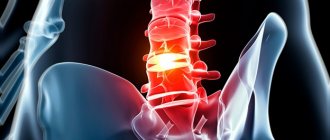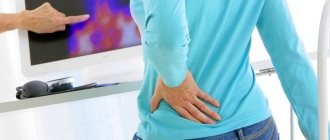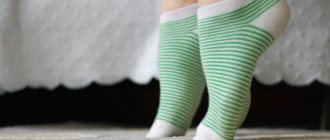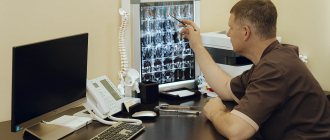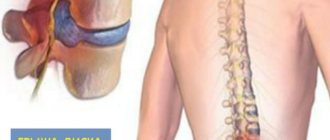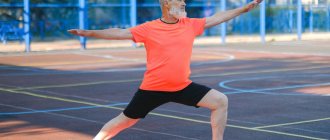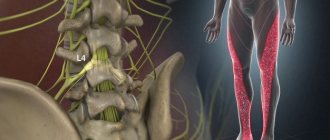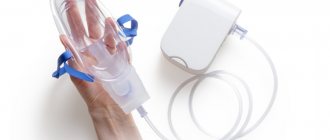From this article you will learn:
- What are the benefits of exercise therapy for the lumbar region?
- The effectiveness of exercise therapy for the lumbar region and the main contraindications
- 10 principles of exercise therapy for the lumbar region
- Features of exercise therapy for osteochondrosis of the lumbar spine
- What you need to know about exercise therapy for the lumbar region
- How to prepare for lumbar exercise therapy
- Effective exercise therapy for the lumbar region depending on the stage of the disease
- Gentle physical therapy exercises for osteochondrosis of the lumbar spine
- Exercise therapy training exercises for osteochondrosis of the lumbar spine
- 5-minute exercise therapy for the lumbar region
- Exercise therapy for the lumbar region with a fitball
- Exercise therapy of the lumbar region according to the method of Bubnovsky and Evdokimenko
Exercise therapy for the lumbar region is one of the most effective methods of treatment and prevention of complications of spinal diseases.
Physical therapy exercises take into account all the features of the pathologies of this zone. But in order to defeat the disease, you need not only to ensure that they are performed correctly, but also to be aware of the existing contraindications.
What are the benefits of exercise therapy for the lumbar region?
Nowadays, almost everyone has heard about spinal osteochondrosis. According to the World Health Organization, 80% of the Russian population has pathologies of the musculoskeletal or musculoskeletal systems. This applies not only to older people, but also to the younger generation aged 29 to 49 years.
Many people feel back pain. It causes discomfort and reduces performance. After therapy, some patients never manage to return to their previous lives, because the disease becomes chronic. This significantly interferes with the return of performance to the previous level or even provokes its cessation.
Back pain is most often related to osteochondrosis. The pathology is very common and can affect anyone.
Osteochondrosis is accompanied by metabolic disorders in intervertebral cartilage and discs. As a result, the muscular and skeletal systems change. It has been proven that the spine has a significant impact on the internal organs, which means they are also subject to pathological transformations. Many doctors say that the most effective therapy for osteochondrosis is physical activity. Therefore, we advise you to pay special attention to exercise therapy for the lumbar spine.
How does osteochondrosis develop?
The spine contains from 33 to 35 vertebrae, and between them are elastic discs. Due to them, it has flexibility and elasticity. The disc has a core covered with cartilage above and below, and along its contour there is a fibrous ring.
Osteochondrosis negatively affects blood circulation and metabolism in the spine. In this regard, the discs dry out, decrease in height, and become less durable and elastic. The fibrous ring does not cope with its function of holding the spine, which leads to its protrusion. In addition, a rupture may occur, resulting in an intervertebral hernia. The consequence of these disorders can be mobility and curvature of the spinal column.
A healthy spine is a reality, but only with an active lifestyle and moderate sports activity. Considering that the age of modern technology forces us to spend most of our time sitting at a computer, do not forget about exercise therapy for the lumbar region. After all, this is the most effective method of treating spinal diseases, as well as their prevention.
Therapeutic exercise has a positive effect on the trophism of elastic discs. As a result, joint mobility improves, the spine is saturated with blood, and its bone components are destroyed more slowly. Exercise therapy for the lumbar region helps to recover after surgery and helps strengthen the back muscles.
Physical therapy is especially recommended for the following population groups:
- Elderly people.
- For those who have previously had vertebral injuries.
- People diagnosed with flat feet and club feet.
- For those who are constantly in a non-standard position.
- People with weak muscles and ligaments.
Osteochondrosis according to the place of occurrence can be classified into osteochondrosis of the cervical, thoracic and lumbosacral spine.
The effectiveness of exercise therapy for the lumbar region and the main contraindications
During movement, the lumbar and sacral regions of the spine receive the main load. The vertebrae of the first zone are very mobile, unlike the vertebrae of the second zone. The latter are a fixed articulation of five vertebrae. Exercise therapy for the lumbosacral region helps strengthen the muscle corset, helps muscles that are constrained by spasms, and relieves pain in them after a pinched nerve.
Gymnastics alternately relaxes and tenses the muscles, which leads to improved blood flow. After an illness, the tissue receives stress and becomes stronger. Classes involve performing various exercises to train specific muscle groups. Exercise therapy is used for hernia of the lumbar spine.
Carrying out physical therapy of the lumbar region on a regular basis contributes to:
- Relief from lower back pain.
- Training of spinal muscle tissues.
- Normalization of joint mobility and blood flow in them.
- Relaxation of spasming muscles.
- Improving blood circulation in the pelvic organs.
- Increasing immunity and general tone of the body.
Exercise therapy for the lumbar region will be effective only if the exercises are performed correctly. Let's look at the basic rules:
- If you are doing physical therapy for the first time, be sure to contact an instructor. Your goal is the right exercises, not quick results.
- In case of exacerbation of the disease, you need to adhere to a special training program and only under the supervision of a trainer.
- Warm up your muscles and ligaments thoroughly before starting exercise. Massage the sacrum, because it bears the greatest load.
- Increase the difficulty gradually. The first workout should include a warm-up and the simplest movements. Duration no more than 20 minutes.
- It is not recommended to eat 1–1.5 hours before class.
- Perform exercise therapy for the lumbar and sacral region on a regular basis. Avoid long breaks. Only in this case can the disease be overcome.
Recommended articles on the topic:
- How to massage the abdomen for weight loss: different techniques for health and beauty
- Stone massage: description, benefits, methods
- MRI of three parts of the spine: when is it necessary and what are the features of the procedure
Undoubtedly, physical therapy is very useful, but not for everyone. Exercise therapy for the lumbar region has a number of contraindications:
- Any bleeding of the body, including uterine.
- The presence of malignant tumors.
- Increased body temperature.
- The period of exacerbation of any chronic disease.
- Swelling and cramps, poor circulation in the legs.
- In the presence of an inflammatory process of any organ. May be accompanied by general malaise or fever.
If, while performing exercise therapy for the lumbosacral region, you notice at least one of the symptoms listed below, consult a doctor immediately. The lesson plan may need to be adjusted:
- Sharp pain.
- Receiving microtraumas and other damage.
- Malaise and deterioration of health.
- Exacerbation of a disease associated with the spine or lumbosacral region.
Physical activity
Prevention of spinal diseases requires regular physical activity. Working out in the gym, long walks, running, and swimming help a lot.
One of the most effective activities is healthy walking, during which the main muscle groups are activated, the performance of the heart and respiratory organs improves, and energy consumption increases. Swimming is also used for preventive purposes, since water makes it possible to increase the range of joint movements and relax the muscles.
Features of exercise therapy for osteochondrosis of the lumbar spine
Most often, pain is felt in the lumbar spine, since it bears the main load. This is due to the anatomy of the human body structure.
Symptoms of osteochondrosis of the lumbosacral region include pain in the legs and lower back. Their cause lies in irritation of the spinal nerve roots. Swelling forms around the irritated area of the root, increasing the pain and causing it to spread to the muscles. The affected area is affected by the resulting spasm. The process is a vicious circle. But it can be interrupted by influencing the muscle system and strengthening the muscle corset.
We recommend
Anti-wrinkle facial massage: 10 effective techniques Read more
How to do this? Exercise therapy for the lumbar region, massage and useful habits in everyday life will help you here. If pain is observed in the lower back or legs, it is necessary to perform gymnastics in a lighter form.
The objectives of exercise therapy for osteochondrosis of the lumbar spine are to:
- relax and stretch tense back muscles;
- strengthen lymph and blood circulation in the lumbar region.
Follow the principles of gymnastics described above. Clearly remember what not to do, and then exercise therapy for the lumbar region will be useful and effective.
Massage and self-massage
Massage is a fairly effective way to prevent osteochondrosis, thanks to which it is possible to eliminate excessive muscle tension and increase muscle tone. As a rule, the procedure is carried out in courses. Between sessions, muscle condition can be maintained with self-massage. One procedure should last about 10-15 minutes.
To avoid the development of spinal diseases, special attention should be paid to their prevention. It is necessary to properly organize the conditions of rest and work, do massage and perform physical exercises. Everyone is able to prevent the development of osteochondrosis with the help of simple preventive measures that do not take much time and bring long-term benefits and effects.
What you need to know about exercise therapy for the lumbar region
The basic requirements for physical therapy are as follows:
- Classes can be started only after pronounced pain has been eliminated.
- During an exacerbation of osteochondrosis, it is recommended to do only simple movements.
- Training should be carried out on a regular basis during remission of the disease.
- Increase the range of motion and number of repetitions gradually.
- Watch your breathing, it should be measured and calm.
- Movements should be smooth. If you feel pain, you should end the session.
- The first training should be carried out strictly under the supervision of an instructor.
- Before classes, contact a specialist for advice and a program.
- Wear only breathable clothing.
If you have problems with the lumbar spine during exercise therapy, it is prohibited to:
- Use maximum loads at the very beginning of your workout.
- Make movements that lead to painful sensations.
If osteochondrosis worsens, perform exercises only in bed.
During exercise therapy for hernias and protrusions of the lumbar and sacral regions, it is contraindicated to lift weights while standing, do leg presses while lying down, jump and run.
Treatment
Only proper treatment will help you cope with pain and discomfort. Usually it is prescribed by a doctor only after a thorough diagnosis and an appropriate diagnosis has been made - it is important to make sure that it is osteochondrosis that is being dealt with.
Treatment of this pathology consists of using a number of medications, attending physiotherapeutic procedures and physical therapy classes. Acupuncture, which is often prescribed by doctors, will help restore back mobility and eliminate spasms. The circulatory system begins to work better, thereby improving the quality of nutrition of the spinal tissues.
How to prepare for lumbar exercise therapy
Physical therapy may be prescribed by a doctor after the results of the examination. Don't forget about the rules that will help you make it effective:
- The best time for classes is before lunch. The last meal should take place 1.5 hours before they start.
- Every workout should start with a warm-up. It helps warm up muscles and ligaments, prepares the heart for stress.
- During the exercise, use a roller under your knees at the correct height (the thigh and shin are perpendicular to each other).
- Record the exercises you perform in your diary and monitor the results.
For osteochondrosis, there is a whole complex of gymnastics. Exercises vary in difficulty and stages. Follow the lesson plan without combining them with each other.
The lumbar exercise therapy program is divided into blocks that are intended for a specific stage.
The first stage is carrying out exercise therapy in the acute period . As simple and slow movements as possible.
The second stage is the subacute period . If the pain has decreased, you can increase the load, but gradually.
The third stage is remission . The pain has stopped, complex exercises are included.
Choose loose clothing that will not interfere with your workout. We recommend paying attention to a cotton T-shirt or tank top, shorts or sweatpants. If you exercise outside in cold weather, use woolen items.
Inventory you will need:
- Gymnastic ball.
- Swedish wall.
- Pillow for the knees.
- Fitness mat.
The importance of physical therapy for cervical osteochondrosis
Therapeutic exercise (physical therapy) is a preventive exercise that prevents exacerbation of various diseases and is used very effectively for cervical osteochondrosis. Repeating the same exercise several times brings undeniable benefits. Exercise therapy significantly improves the patient’s condition and helps cope with pain. Osteochondrosis gradually recedes, because after exercise therapy:
- blood supply noticeably improves;
- the muscles of the neck and back are strengthened;
- the spine in the neck area becomes mobile;
- pinched nerves are restored;
- improves neck flexibility and shoulder movement;
- pain decreases.
Effective exercise therapy for the lumbar region depending on the stage of the disease
1. Acute period.
Exercise therapy for exacerbation of osteochondrosis of the lumbar spine should be carried out only under the supervision of a trainer. Make slow movements. If pain occurs, training should be stopped. The exercises are performed from a lying position.
- It is necessary to develop the feet by performing movements of flexion and extension. First together, then after each other. Increase the pace whenever possible. Clench your fingers into a fist and then unclench them.
- I. p. – bend your legs at the knee joint. Extend one leg, your heel should slide across the bed. Repeat for the other leg. Do eight reps.
- Raise your hand up. Once you lower it, repeat for the other hand.
- Bend your left leg and move your right leg to the side. Repeat, switching the position of your legs with each other. The exercise loads the lumbar region. Avoid sudden movements. They can put increased pressure on nerve cells and aggravate osteochondrosis.
- I. p. – put your hands on your shoulders. Move in a circle. First clockwise and then counterclockwise.
- Rest your thighs on the bolster. Straighten your legs at the knee joint one at a time.
- As you exhale, bend your arms, trying to touch your shoulders. As you inhale, straighten, touching your thighs with your fingertips.
- I. p. – bend your legs at the knee joint. Move one knee to the side and return to the starting position. Repeat the same with the other one.
- Stretch your arms up. At the same time, pull your socks towards you. After lowering your arms, relax.
- I. p. – bend your legs at the knee joint. Spread and bring your knees together. You can diversify the movements by moving your knees first to one side, then to the other.
- Try to pull your bent knees one after the other towards your stomach. Help with your hands when doing this.
We recommend
Therapeutic massage for the back: features, indications and contraindications More details
2. Subacute period.
If there is an improvement in the course of the disease, the pain has subsided, you can diversify exercise therapy for the lumbar spine with more dynamic movements.
- I. p. – bend your legs at the knee joint. Straighten your right one up. Repeat for the left, four times on each. Do not straighten your leg completely if you experience pain.
- Lean on the bed with your arms bent. Try to arch your chest as much as possible. After completing the exercise, relax.
- In a lying position, you need to bend your legs and raise your back area in the sacrum area. Try to lean on your lower spine.
- Tighten and relax your buttocks.
- Bend your legs one after the other. While straightening them, press down on the bed with your foot and try to arch your lower back a little.
- Lie down and bend your legs. Raise your head while contracting your abdominals and buttocks. If the exercise is easy, try raising your pelvis a little.
3. Remission.
Exercise therapy for osteochondrosis of the lumbar spine in remission can be supplemented with complex movements. At the same time, the load increases, which means you need to carefully monitor your condition even without pain. Physical overexertion is dangerous and can lead to a sudden exacerbation of the pathology.
- I. p. - lying on the side. Pull one thigh toward your stomach first, then the other. Try to do the exercise all the way, thereby stretching the lower back muscles as much as possible. Perform five to seven repetitions on each leg.
- I. p. - on all fours. Imagine an obstacle and carefully crawl under it.
- I. p. - sitting on a hard surface, hands on knees. The back is straight. Slowly lean back, tensing your abdominal muscles. Stay a while. Return to the starting position at the same pace.
- I. p. - on all fours. Arch your back while lowering your head. Make reverse movements: arch your back, raising your head up.
- Stand up straight. Bend forward, trying to reach your toes with your hands. The chest should be pressed against the hips as much as possible. The exercise is also effective from a sitting position.
- I. p. - on all fours. Raise your legs bent at the knee joint and bend your lower back slightly. Movements help relieve symptoms of osteochondrosis.
- The legs are bent at the knee joint. Sit on them, and your heels should be level with your buttocks. Reach up and interlock your fingers. Sit on the floor, changing direction: first left, then right.
- I. p. - on all fours. Raise your arm and opposite leg. Stay in this position for a while. After returning to the starting position, repeat with the other limbs. Do five times for each side.
Gentle physical therapy exercises for osteochondrosis of the lumbar spine
1. Lying on your back.
- Hands at your sides, legs together. As you inhale, pull your arms up, and as you exhale, lower them. Number of repetitions – 4-5.
- Bend and straighten your feet while clenching and unclenching your fists. Do it 10 times.
- Rotate your feet in a circle. In each direction 4-6 times.
- Pull your knees to your chest one at a time. Do 6-8 reps.
- Move your right arm and leg to the side, for example. Repeat in the same way for the left limbs. Do 4-6 repetitions.
- Clasp your fingers in a “lock” at the back of your head. Raise your head while pulling your toes towards you. Number of repetitions – 8.
- Hands at your sides. As you inhale, stretch your arms up, while simultaneously pulling your toes in the opposite direction from you.
- Place your legs bent at the knee joint, shoulder-width apart. Use your knee to touch the opposite foot, and vice versa. Do 4-6 times.
- Exercise “bicycle”, simulating pedaling. Repeat five circles back and forth.
- Place your hand on your stomach. Take a deep breath into your belly and then exhale slowly. Number of repetitions – 3-4.
- Stretch your left hand along your body, and stretch your right hand up. Repeat the exercise, changing the position of your hands. Do 10–12 times.
- Spread your arms to the sides, feet shoulder-width apart. With your left hand, reach your right hand. Repeat the exercise for opposite limbs. Number of repetitions – 6–10.
- Pull your knees towards your chest with your hands. First the left knee, then return to the starting position and repeat the exercise with the right. Do 6-8 times.
2. Exercise therapy lying on your side.
- Swing your arm and leg upward. Repeat about five times.
- Pull your knees to your chest: 6-8 reps.
- Swing your leg forward and backward. Repeat 6-8 times.
Perform the exercises in the same way, lying on the other side.
3. Exercises while standing on all fours.
- First move one hand to the side, then the other. Do 10–12 reps.
- Swing your leg back, straightening it. Repeat with the other leg. The quantity for each is 8–10.
- Pull your left knee towards your right hand. Repeat, switching sides of limbs. Do 6-8 times.
- Pull one knee toward your chest. After this, take your leg back, the toe should slide along the floor. At the same time as this movement, you need to sit on the opposite heel. Perform the exercise in the same way with the other leg.
- Swing your straight leg up and back. At the same time, pull your opposite hand up. Repeat similarly for the other leg and arm. Do 6-8 times.
- The legs are fixed in one position, and move your hands to the right and left sides. Repeat five times in each direction.
- Without lifting your hands from the floor, try to sit on your heels. The exercise is performed slowly. Do 6-8 times.
- Without lifting your hands from the floor, sit first on your left buttock and then on your right. Repeat 6-8 times.
- Place your hands on the floor and raise your head. Arms straight. Lower your head to your chest and arch your back, then arch it back. Make movements at a slow pace. Number of repetitions – 8–10.
Reduced external loads
To prevent the disease, patients suffering from osteochondrosis need to learn to perform all movements correctly, which will significantly reduce the load on the spinal regions. We need to relearn how to lie and stand, run and walk, work, drive and jump. Many people think that it’s easy, but they already know how to do everything, so they don’t need to learn anything. The problem is that these steps are usually performed incorrectly. Let's look at how to perform these movements to prevent disease and protect the spine as much as possible from excessive stress.
How to stand and sit correctly
If a person has to stand in one position for a long time, it is necessary to sometimes change the supporting leg. To take some of the load off your spine, you can lean on something if possible. It is not recommended to sit in one position for a long time: you need to get up and warm up every half hour. When sitting in a chair at your workplace, you should choose a position so that your back rests against the wall of the chair. While sitting, you need to keep your back straight, watching your posture. When sitting correctly, your feet should rest on the floor.
How to sleep properly
To prevent spinal diseases, orthopedic pillows and mattresses are an excellent remedy. The surface on which a person sleeps should be moderately hard and hard, not soft. In order to prevent osteochondrosis of the cervical spine, it is recommended to purchase a fairly dense, low pillow. It will help maintain the cervical spine in the desired position.
How to run and jump
For such active activities, you need to choose high-quality elastic shoes with shock absorption. Sharp turns of the body and high jumps should be avoided. You will also need comfortable shoes for daily walking. Women are advised to choose low-heeled shoes instead of high heels.
How to carry and lift weights
A patient who suffers from osteochondrosis is not recommended to lift weights weighing more than 10 kg. Also, you should not lift any weight with sudden jerks. Before lifting, you need to sit down, grab and press the object towards you. Then you can get up, while trying to keep your back straight, without leaning forward. Suitcases and bags should be carried in both hands, distributing the load evenly. The ideal option would be a suitcase on wheels.
Exercise therapy training exercises for osteochondrosis of the lumbar spine
For exercise therapy of the lumbar region, training exercises are indicated while the pain subsides. During the acute stage they are prohibited.
Tasks:
- Completely form the muscle corset.
- Normalize the range of motion in the leg joints.
- Repeat the number of exercises that include movements in the lumbar region strictly in accordance with the training plan.
1. Lying on your back.
- Bend your legs at the hip and knee joints. The shins should rest on the support. Join your fingers behind your head into a “lock.” Lift your head and shoulders off the floor. Do 6-8 times.
- The shins rest on the support. Hold the ball between your feet. Move it to the left, then to the right. Do 6-8 reps.
- Hold the heavy ball with your feet. The shins rest on the support. Your task is to pull your knees towards your chin, lifting your head off the floor. Perform 6–8 times.
- Bend your legs at the hip joint. The shins should rest on the support. Take dumbbells in your hands and stretch them along your body. Try to sit down. Do 6-8 times.
- Take dumbbells in your hands and move them to the right. At the same time, tilt your knees to the left. Repeat 6-8 times.
- Bend your knees and hold the ball between your feet. Take dumbbells. Try to sit down and hold this position. Do 6-8 reps.
2. Lying on your stomach.
- Stretch your hands in front of you. Raise your head and shoulders at the same time. Move your right arm behind your back, accompanying this movement by turning your torso to the right. Repeat the same with your left hand.
- Place your arms straight behind your back. At the same time, lift your head, shoulders and upper body off the floor. Raise your legs with your knees bent. Repeat 6-8 times.
- The legs need to be bent and then straightened at the knee joint in turn. Only 15–20 times.
Don't forget to take your heart rate before and after your workout. Its optimal value is 120–140 beats per minute. Exceeding the normal heart rate indicates that the load is high for you.
Organization of rest, work schedule and workplace
An important preventive measure to prevent osteochondrosis will be the organization of the workplace. Many people neglect this activity, thereby increasing the risk of spinal problems.
An office chair should be swivel and lift, equipped with a comfortable backrest and armrests. Provide support for your feet so that they rest on the floor. Place the keyboard below your elbows, with the angle between your forearm and shoulder being approximately 120 degrees. The monitor should be positioned so that your eyes can look at its top edge.
When working at a computer, it is important to keep your back straight. Every 30-40 minutes you should take a break to stretch and walk. Often, when staying in one position for a long time, the neck swells, so you can perform special exercises, which will also be an effective preventive measure for osteochondrosis.
When walking, your back should be straight, your head raised high, your shoulders straight. The gait should be springy and smooth.
As a rest, you can lie down, stretching out, and then do several exercises to strengthen the back muscle corset. You can also press your shoulder blades, back of your head and buttocks against the wall, which will make it possible to straighten your spine.
5-minute exercise therapy for the lumbar region
- Lying on your stomach, legs straight, bend your arms at the elbows and press them to your body. Lean on your straight arms and lift your upper body off the floor. Turn your head first in one direction, then in the other. Return to the starting position and relax. Do 2-3 repetitions.
- Lying on your stomach, stretch your arms forward. Legs remain straight. Raise your torso while simultaneously performing a crawl motion with your arms. Repeat 4-6 times.
- Similar to the previous exercise, move your arms using the breaststroke technique. Do 4-6 reps on each arm.
- I. p. - lying on your stomach, hands pressed to your chin. Crawl on your bellies. The movement involves pulling the knee towards the elbow. Repeat 4-6 times.
- The situation is similar to that described above. Lift one of your straight legs up, point your toes down. Repeat the exercise with the other leg. Do 4-6 times.
- Raise your arms and legs at the same time. Hold this position and after a few seconds return to the starting position. Relax. Do 3-4 repetitions.
Exercise therapy for the lumbar region with a fitball
- "Locust". Lie on the fitball with your stomach and take turns lifting your arms and legs.
- Hyperextension. The stomach and thighs lie on the ball. Hands behind your head, legs extended back. As you inhale, bend forward, and as you exhale, return to your starting position. The exercise affects the back, do it smoothly.
- Half bridge. I. p. – lying on the floor on your back, put your feet on the fitball at an angle of 90 degrees. As you exhale, you need to straighten your legs and raise your pelvis. While inhaling, take the starting position.
- I. p. similar to the previous paragraph. Grab the ball with your feet, clasp your hands behind your head. Pick up the exercise ball.
- Twist/"flugel". Back on the floor, feet on a fitball. Hands are spread to the sides. Roll the ball with your legs in different directions. Your goal is to touch your knees to the floor.
Effective exercise therapy for the lumbar region involves repeating these exercises about 20 times.
Exercise therapy of the lumbar region according to the method of Bubnovsky and Evdokimenko
Sergey Bubnovsky is a rehabilitation specialist by profession, the author of a large number of exercise therapy complexes for joints, recognized by official medicine.
Pavel Evdokimenko is a rheumatologist, a member of the highest level of the Academy of Medical Sciences of the Russian Federation. Among his works are a huge number of books that describe recommendations for the treatment of arthritis and arthrosis.
Doctors Bubnovsky and Evdokimenko developed an effective set of exercises. You can familiarize yourself with the technique of their implementation, which will make physical therapy of the lumbar spine more effective, in the video.
- Lying on your stomach, reach your buttocks with your heel, bending your legs one at a time. The head is turned in the opposite direction. Hold the position for 10 seconds. After this, relax for a few seconds and repeat the movement again.
- I. p. - on all fours. Arch your back and hold this for five seconds. After that, relax. Performing the exercise from the side resembles the behavior of a cat on its hind legs, which is why it has a similar name.
- I. p. - lying on your back. First pull one leg towards your stomach, then the other. Help with your hands. Tighten your muscles for seven seconds and then relax.
- I. p. - lying on your back. Wrap your arms around your legs and pull them towards your stomach. Tighten the muscle tissue for 10 seconds, then relax.
- I. p. - sitting on a chair. Bend over slowly. Your task is to thoroughly stretch your back. As you inhale, tighten your lower back muscles for six to seven seconds, and as you exhale, relax.
Video instructions for exercise therapy of the lumbar spine:
.
Nowadays, you no longer have to spend a lot of time performing complex and unpleasant procedures at home. It is much easier to seek help from real professionals - the Veronika Herba beauty and health center, equipped with effective and modern equipment.
Why clients choose Veronika Herba beauty and health center:
- This is a beauty center where you can take a course of exercise therapy for the lumbar region at a reasonable cost, and you will be treated not by an ordinary cosmetologist, but by one of the best specialists in Moscow. This is a completely different, higher level of service!
- You can receive qualified help at any time convenient for you. The beauty center is open from 9:00 to 21:00, seven days a week. The main thing is to agree with your doctor in advance on the date and time of your appointment.
Sign up for a consultation with a specialist by phone +7 (495) 085-15-13, and you will see for yourself!
